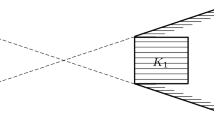Abstract
A family of pairwise disjoint compact convex sets is called convexly independent, if none of its members is contained in the convex hull of the union of the other members of the family. The main result of the paper gives an upper bound for the maximum cardinalityh(k, n) of a family ℱ of mutually disjoint compact convex sets such that any subfamily of at mostk members of ℱ is convexly independent, but no subfamily of sizen is.
Similar content being viewed by others
References
T. Bisztriczky, andG. Fejes Tóth: A generalization of the Erdős-Szekeres convexn-gon theorem,J. reine angew. Math. 395(1989) 167–170.
T. Bisztriczky, andG. Fejes Tóth: Nine convex sets determine a pentagon with convex sets as vertices,Geometriae Dedicata 31(1989) 89–104.
P. ErdőS, andG. Szekeres: A combinatorical problem in geometry,Comp. Math.,2 (1935), 463–470.
P. Erdős, andG. Szekeres: On some extremum problems in elementary geometry,Ann. Univ. Sci. Budapest, Eötvös Sect. Math.,3–4 (1960–61), 53–62.
R. L. Graham, B. L. Rothschild, andJ. H. Spencer:Ramsey theory, Wiley, New York (1980).




